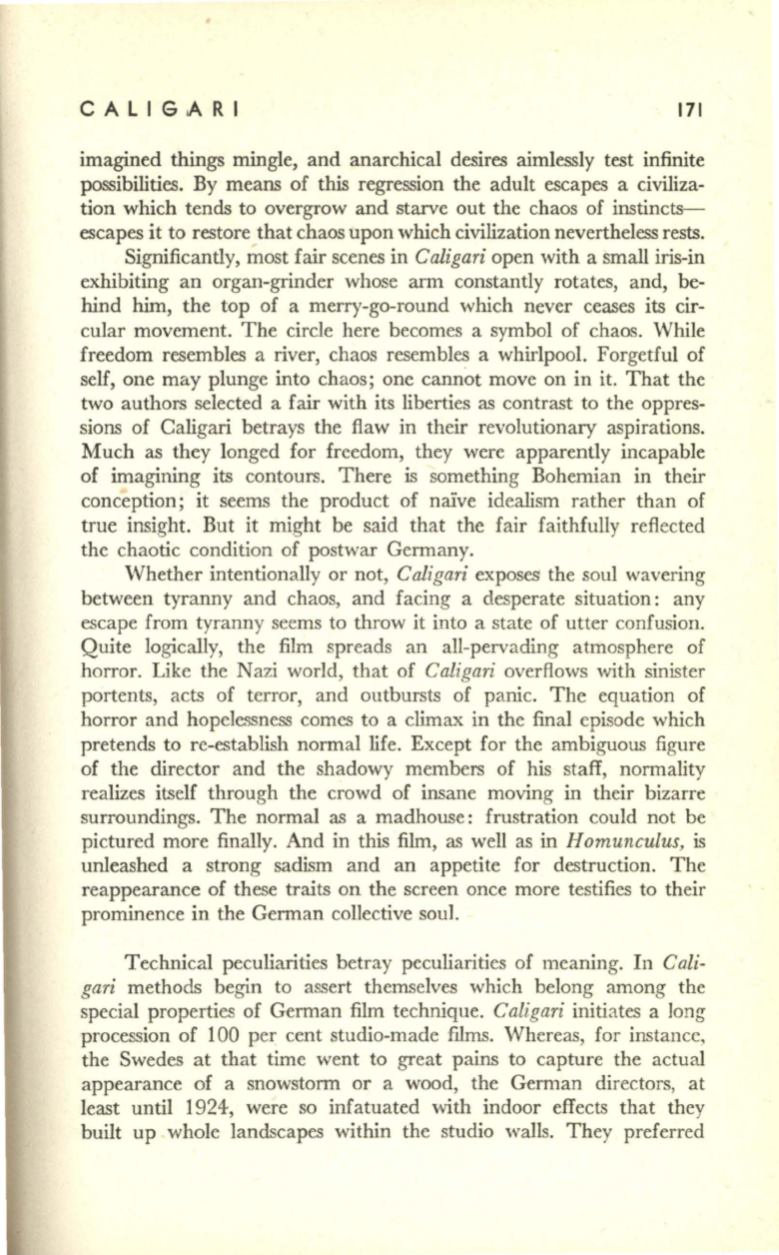
CALIG.ARI
171
imagined things mingle, and anarchical desires aimlessly test infinite
possibilities. By means of this regression the adult escapes a civiliza–
tion which tends to overgrow and starve out the chaos of instincts–
escapes it to restore that chaos upon which civilization nevertheless rests.
Significantly, most fair scenes in
Caligari
open with a small iris-in
exhibiting an organ-grinder whose arm constantly rotates, and, be–
hind
him,
the top of a merry-go-round which never ceases its cir–
cular movement. The circle here becomes a symbol of chaos. While
freedom resembles a river, chaos resembles a whirlpool. Forgetful of
self, one may plunge into chaos; one cannot move on in it. That the
two authors selected a fair with its liberties as contrast to the oppres–
sions of Caligari betrays the flaw in their revolutionary aspirations.
Much as they longed for freedom, they were apparently incapable
of imagining its contours. There is something Bohemian in their
conception; it seems the product of naive idealism rather than of
true insight. But it might be said that the fair faithfully reflected
the chaotic condition of postwar Germany.
Whether intentionally or not,
Caligari
exposes the soul wavering
between tyranny and chaos, and facing a desperate situation: any
escape from tyranny seems to throw it into a state of utter confusion.
Quite logically, the film spreads an all-pervading atmosphere of
horror. Like the Nazi world, that of
Caligari
overflows with sinister
portents, acts of terror, and outbursts of panic. The equation of
horror and hopelessness comes to a climax in the final episode which
pretends to re-establish normal life. Except for the ambiguous figure
of the director and the shadowy members of his staff, normality
realizes itself through the crowd of insane moving in their bizarre
surroundings. The normal as a madhouse: frustration could not be
pictured more finally. And in this film, as well as in
Homunculus,
is
unleashed a strong sadism and an appetite for destruction. The
reappearance of these traits on the screen once more testifies to their
prominence in the German collective soul.
Technical peculiarities betray peculiarities of meaning. In
Cali–
gari
methods begin to assert themselves which belong among the
special properties of German film technique.
Caligari
initiates a long
procession of 100 per cent studio-made films. Whereas, for instance,
the Swedes at that time went to great pains to capture the actual
appearance of a snowstorm or a wood,
the
German directors, at
least until 1924,
were
so infatuated with indoor effects that they
built up whole landscapes within
the
studio walls. They preferred


